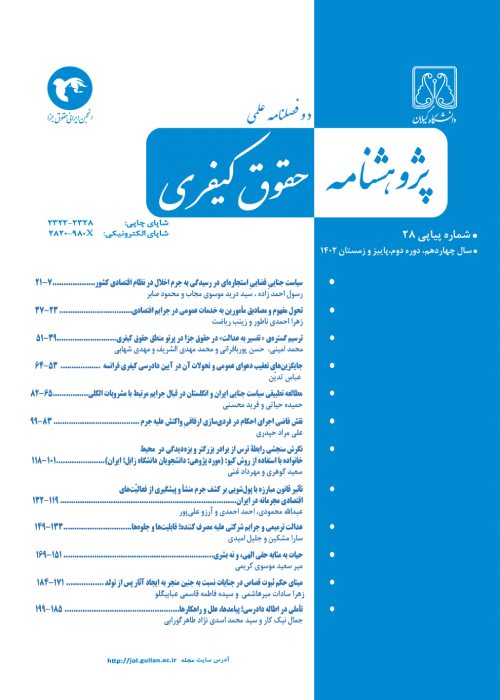Evaluating the Victimization Rate of Digital Sexual Harassment on Adults by Looking at Transgender People
Author(s):
Article Type:
Research/Original Article (دارای رتبه معتبر)
Abstract:
Background and Aim
This article also examines the extent of digital sexual harassment of adults by looking at transgender people. Materials and Methods
The present study is applied in terms of purpose and quantitative in terms of data collection by survey method. The statistical population of the study is Trans people living in Tehran, and next to them, a control group consisting of men and women aged 18 to 55 in Tehran was placed. Findings and Conclusion
The rate of sexual harassment is not the same between different sexes and is higher in transgender people. It was also found that, based on the statistical data of this study, the most common type of digital harassment is trying to establish romantic relationships. There is no statistically significant relationship between the use of social networks and software and the rate of digital sexual harassment. 1. Introduction Admittedly, the term "cyberbullying" is very rare in adults because of the ways in which the mass victim can be labeled an adult through the mass media and even domestic law. Our main focus in this study is on adults aged 18 to 55 with an emphasis on transgender sexual minorities because very little research has been done on crimes related to digital harassment. 2. Research methodThe present study is applied in terms of purpose and quantitative in terms of data collection by survey method. The statistical population of the study is trans people living in Tehran, and next to them, a control group consisting of men and women aged 18 to 55 in Tehran was placed. 3. Results and DiscussionFor the first hypothesis, analysis of variance was used, which showed that the rate of digital sexual harassment in transgender people is higher than women and men. Regarding the mean and standard deviation of the variables of digital sexual harassment, the highest mean is related to the variable of trying to establish romantic relationships, equal to 2.68, and the lowest mean is related to receiving scary letters or messages or computer virus in e-mail and other cyberspace for Having sex is equal to 1.06. Regarding the last hypothesis, Pearson correlation coefficient test is used and the results of correlation coefficient test show that there is a correlation coefficient of 0.03 between the rate of use of social network and software and the rate of sexual harassment, which indicates a very weak linear relationship. In other words, there is no statistically significant relationship between the use of social networks and software and the rate of digital sexual harassment. 4. Conclusion In this study, it was concluded that the rate of sexual harassment is not the same between different sexes and is higher in transgender people. It was also found that, based on the statistical data of this study, the most common type of digital harassment is trying to establish romantic relationships. There is no statistically significant relationship between the use of social networks and software and the rate of digital sexual harassment. Selection of ReferencesBernstein, A., Abuse and Harassment Diminish Free Speech (2016), Pace Law Review, Vol. 35, No. 1, 2014; Brooklyn Law School, Legal Studies Paper No. 432. Farhadi Alashti, Z. and Javan Jafari, A. (2017), “Cross-border challenges in the effective prevention of cross-border cybercrime”, Quarterly Journal of Intelligence and Criminal Research, Volume 12, Number 1, pp. 9-32. [In Persian]Guasp, A. Gammon A, Ellison G (2013), Homophobic Hate Crime: The Gay British Crime Survey 2013. London: Stonewall and YouGov. URL (accessed 6 June 2017). Jalili, Z. and Attarzadeh, S. (2017), “Laws and issues related to delinquency and transgender victimization in Iran and the United States”, the third national conference of the third millennium and humanities, Bandar Abbas. . [In Persian] Oxford Wordp Selection of References ower Dictionary 4th edition (2018), Translator: Abolghasem Toloo, Jungle PublishingPatrícia Brás, Vítor Alexandre Coelho, Marta Marchante (2016), Bullying and cyberbullying in Portugal: Validation of a questionnaire and analysis of prevalence, February, School Psychology International 37 (3).Keywords:
Language:
Persian
Published:
A Biannual Journal Criminal Law Research, Volume:13 Issue: 1, 2022
Pages:
205 to 224
magiran.com/p2455729
دانلود و مطالعه متن این مقاله با یکی از روشهای زیر امکان پذیر است:
اشتراک شخصی
با عضویت و پرداخت آنلاین حق اشتراک یکساله به مبلغ 1,390,000ريال میتوانید 70 عنوان مطلب دانلود کنید!
اشتراک سازمانی
به کتابخانه دانشگاه یا محل کار خود پیشنهاد کنید تا اشتراک سازمانی این پایگاه را برای دسترسی نامحدود همه کاربران به متن مطالب تهیه نمایند!
توجه!
- حق عضویت دریافتی صرف حمایت از نشریات عضو و نگهداری، تکمیل و توسعه مگیران میشود.
- پرداخت حق اشتراک و دانلود مقالات اجازه بازنشر آن در سایر رسانههای چاپی و دیجیتال را به کاربر نمیدهد.
In order to view content subscription is required
Personal subscription
Subscribe magiran.com for 70 € euros via PayPal and download 70 articles during a year.
Organization subscription
Please contact us to subscribe your university or library for unlimited access!


